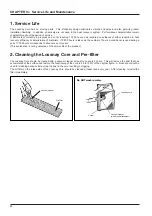
86
CHAPTER 8
●
Filtering for Freshness
1. Necessity of Filters
Clean air is necessary for humans to live a comfortable and healthy life. Besides atmospheric pollution that has been
generated with the development of modern industries and the growth in the use of automobiles, air pollution in air-tight room
has progressed to the point where it adversely affects the human body, and is now a major problem.
Hay fever is now a symptom often seen in the spring and demands for preventing pollen from entering rooms are increasing.
2. Data Regarding Dust
The particle diameter of dust and applicable range of filters are shown in Table 1, and representative data regarding outdoor
air dust concentrations and indoor dust concentrations is shown in Table 2.
Table 1 Aerosol particle diameters and applicable ranges of various filters
Aerosol particle diameter (µm)
Solid
particles
Fumes
Dust
Mist
Clay
Oil fumes
Tobacco smoke
Carbon black
ZnO fumes
Sea salt
particles
Atmospheric
dust
Fine dust, coarse
dust fillers
Cement
Pollen
Viruses
Bacteria
Hair
Medium to high efficiency filters
HEPA filter
Coal dust
Fry ashes
Mud
Sand
Sprays
Fluid
particles
Air filters
Major
particles
Aerosol particle
0.001
0.01
0.1 0.3
1
10
100
1000
Table 2 Major dust concentrations
Type
Reference data
Outdoor air floating dust
Large city
0.1 - 0.15 mg/m
3
concentration
Small city
0.1 mg/m
3
or less
Industrial districts
0.2 mg/m
3
or more
General office
10 mg/h per person
Indoor dust concentration
Stores (product vending stores)
5 mg/h per person
Applications with no tobacco smoke
5 mg/h per person
Remarks:
1. The core diameter of outdoor air dust is said to be 2.1 µm, and the 11 types of dust (average diameter 2.0 µm) as set by
JIS Z8901 as performance test particles are employed.
2. Dust in office rooms is largely caused by smoking, and the core diameter is 0.72 µm. The 14 types of dust (average 0.8
µm) as set by JIS Z 8901 as performance test particles are employed.
3. The core diameter of dust generated in rooms where there is no smoking is approximately the same as outdoor air.
4. Smoking in general offices (as per Japan):
Percentage of smokers
: Approx. 70% (adult men)
Average number of cigarettes : Approx. 1/person·h (including non-smokers)
Smoking length of cigarette
: Approx. 4 cm
Amount of dust generated by one cigarette : Approx. 10 mg/cigarette
Summary of Contents for Lossnay PZ-41SLB-E
Page 4: ...CHAPTER 1 Ventilation for Healthy Living Lossnay Unit ...
Page 17: ......
Page 18: ...CHAPTER 2 Lossnay Construction and Principle ...
Page 24: ...CHAPTER 3 General Technical Considerations ...
Page 41: ......
Page 42: ...CHAPTER 4 Characteristics ...
Page 56: ...53 CHAPTER 4 Characteristics ...
Page 57: ...54 CHAPTER 4 Characteristics ...
Page 59: ......
Page 60: ...CHAPTER 5 System Design Recommendations ...
Page 68: ...CHAPTER 6 Examples of Lossnay Applications ...
Page 83: ......
Page 84: ...CHAPTER 7 Installation Considerations ...
Page 88: ...CHAPTER 8 Filtering for Freshness ...
Page 96: ...CHAPTER 9 Service Life and Maintenance ...
Page 98: ...CHAPTER 10 Ventilation Standards in Each Country ...
Page 101: ......
Page 102: ...CHAPTER 11 Lossnay Q and A ...
Page 108: ...Lossnay Remote Controller ...
Page 109: ......
Page 197: ...MEMO ...
Page 198: ...Y04 002 Jul 2004 MEE ...
















































